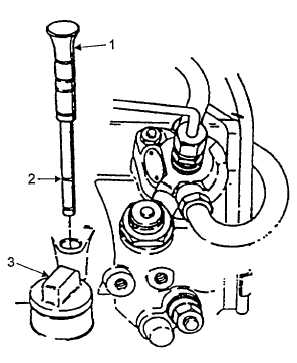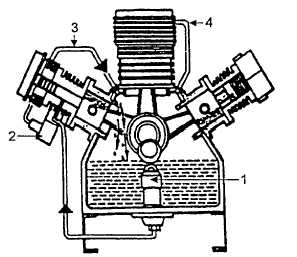TM 5-4310-393-14
b.
If oil coating is below top mark, remove oil cap (3) and fill with oil of proper viscosity as required.
c.
Select an oil viscosity grade to suit ambient temperature using Figure 3-1.
d.
After adding oil, check oil level again to be sure oil coats dipstick to top mark.
e.
If oil coating extends above the top mark, loosen
drain plug (Figure 1-2, Item 6) and drain enough oil to
lower the oil level to top mark on dipstick then tighten
drain plug securely The drain plug is located in the base
of
the
engine
opposite
the
flywheel,
below
the
crankshaft.
f.
When the procedure is complete, ensure that oil
cap (3) is securely replaced.
3-5. LUBRICATION OF COMPRESSOR.
The third stage is force lubricated by a pump (Figure 3-3,
Item 1) operated by a cam of the crankshaft The oil
pressure regulator valve (2) maintains the proper
working pressure Any oil not needed by the third stage is
returned to the crankcase through the feedback tube (3).
Other moving parts of the compressor are lubricated with
oil splashed by the crankshaft Cylinders of the first and
second stages receive additional lubrication from oil
vapors from the crankcase vent feedback line (4).
3-5.1. Operation Under Severe Conditions.
For operation under severe operating conditions such as
continuous running and/or high ambient temperatures,
the use of synthetic compressor oil is recommended.
This oil can also be used under normal conditions. See
paragraph 3-6 for oil specifications
3-5.2. Compressor Oil Level Check.
Check the oil level before starting the compressor. To
check the oil level, vent any residual pressure from the
system by opening and then closing the manual drain
valves/purge valves on the separators and purification
system. Open the filler cap slowly, allowing any residual
pressure to vent from the crankcase Remove the
cap/dipstick from the oil filler neck. Wipe the dipstick
with a lint-free cloth.
FIGURE 3-2. ENGINE OIL FILL
FIGURE 3-3. COMPRESSOR OIL SYSTEM
3-3



